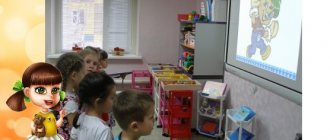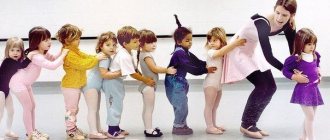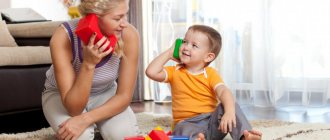Summary of educational activities for FEMP in the early age group “Houses for a bear”
Summary of GCD for FEMP
in the early age group "Houses for a Bear"
Objectives: 1.Teach the ability to compare objects by size
visual correlation method;
2. Sort objects of two different sizes;
3. Learn to distinguish between the number of objects: “one - many” and “big - small”
4. Learn to answer the question “how much?”
5.Development of the ability to follow certain rules when solving problems;
6. Development of thinking and attention;
7. cultivate interest in the activity; make you want to do simple tasks.
Materials used: bear toy, large and small cubes, large and small cars.
Progress of the lesson
Educator: Guys, a guest has come to us! But to find out
Who is this, we need to guess a riddle about him.
Listen here:
The furry beast loves honey. If he doesn’t understand something, he may roar wildly, because he is... (a bear)
Children: Bear!
Educator: That's right, guys, it's a bear. .
Look, there he is. But he didn’t come to visit us empty-handed, he was carrying something in the car. What is this bear in the car?
Children: Cubes!!!
Educator: That's right, these are cubes. But why does the bear need so many cubes? Shall we ask him?
Bear: I wanted to build a house out of cubes for my cubs: for big cubs - from large cubes,
for little bear cubs - from small cubes, but suddenly the fox cubs came running and mixed all the cubes, and now I just can’t figure it out. What should I do now...
Educator: Don’t be sad, bear, we will help you!!!
Really, guys?
Children: Yes!!!
Educator: We will sort out the cubes, bring your truck here quickly.
Educator: Look, guys, I have a big house on this table, and a small one on this table. What kind of cubes do you think are suitable for a large house?
Children: Big cubes.
Educator: That's right. What cubes are suitable for a small house?
Children: Little ones.
Educator: Correct. Then let's divide the cubes into two piles.
(Children are asked to arrange the cubes by size)
Educator: Well, bear, how did the guys help you?
Bear: Thanks, guys!
Educator: Guys, our little bear is feeling cold, let’s show him how to quickly warm up.
Physical education minute:
Stomp, bear
Clap, bear
Squat with me, brother,
Hands up, forward and down.
Smile and sit down.
Educator: Guys, our bear needs to return home. But how can he take the cubes home? They might get mixed up again. What do we do?
(Children's guesses)
Educator: Look, I have another car. What is she like? Big or small? (The teacher places the previous car next to it so that the children can visually compare them)
Abstract of GCD in mathematics in the 1st junior group “I’m going to visit a hedgehog”
Summary of mathematics lesson in 1st junior group
“I’m going to visit the hedgehog”
Program content:
1. Learn to select objects based on color, by display and by verbal designation.
2. Develop ideas about geometric shapes.
3. To consolidate children's knowledge of colors and shapes.
4. To develop the ability to isolate and combine objects according to one (common) characteristic.
5. Develop imagination, memory, imaginative thinking.
6. Cultivate curiosity, expand the experience of orientation in the environment, enriching children with a variety of sensory impressions.
Demonstration material.
Two screens: one depicts a large house, the other a small one. Two ribbons: short - red, long - green, two toy bears, geometric shapes: circles, squares (green, blue and yellow), hoops yellow, green and blue, two cars - large and small, cubes and balls : large and small (yellow, green and blue).
Progress of the lesson:
Educator: Today we will go to visit our friends, and who you will now find out.
Instead of a fur coat there are only needles.
Wolves are not afraid of him either.
A sharp ball, no legs visible,
Of course his name is...
(Hedgehog)
Educator: Of course, these are hedgehogs, but in order to get to them, we need to go along the longest path (there are two paths on the floor: a long one - green and a short one - red).
Educator: Let's go along the long path, which of the two paths is longer - red or green? (Red.)
Lay out the green ribbon: one end of it is near the children’s feet, the other is near the screen with pictures of houses. Children follow the teacher along the tape and approach the screen.
Educator: We walked and walked and came to the houses of our friends. Children, what are the names of our friends?
Children: Hedgehogs?
Educator: What kind of hedgehogs are they?
Children: Prickly. Brown. Big ones.
Educator: Look at the houses the hedgehogs have. Are they the same? (No, one is big, the other is small). What size are they? (one big, one small)
Educator: What house do you think the big hedgehog lives in (in a big house)
.
And where does the little hedgehog live (in a small house)
.
Place the toys next to the corresponding houses.
Educator: Children, for some reason our hedgehog friends are very, very sad. Oh, they need our help! Their friend Bunny sent them toys, here they are, but they are all mixed up and now they don’t know where whose toys are (I show toys: 2 cars, cubes, balls of different sizes and colors)
. Shall we help?
I show the toys and ask:
Educator: What is this? That's right, the ball.
How big or small is it?
What color is the little ball?
Who do you think should put it in? A big hedgehog or a small one?
Educator: Of course, to the little hedgehog.
Educator. You guys are great, the hedgehogs thank you for your help. And for this they want to give you their toys - counting sticks. Guys, what color are the sticks? (Children name the colors).
How many are there?
( Children name the number of sticks)
Educator: Guys, what shapes can be assembled from these sticks?
(children assemble stick figures)
Guys, did you enjoy playing? (children share their impressions)
.
What did you do, what did you do? (we looked for houses for figures by color, selected toys by size, assembled figures from sticks).
Well done boys. Now it's time for us to return to kindergarten.
Why preparation is needed
This preparation involves not only the acquisition by children of certain knowledge, but also its formation. In such classes, children develop various ideas about the world around them, such as spatial, quantitative, temporal and many others. It is important to develop thinking precisely in preschool age, so that the child learns to solve various kinds of tasks and is ready for the gradual complication of the program. Depending on the age group, children undergo different educational programs in kindergarten. In our group, children, in particular my child, get acquainted with geometric shapes and their colors, which helps develop imagination and imaginative thinking.
In groups where older children are already working with numbers and solving simple problems.
Such preparation is necessary in preschool age, because it is during this period that the child’s perception of the outside world is formed, and thinking begins to develop from the age of 2. My son finds such activities interesting and fun. Sometimes at home we cut out the same shapes from paper, draw on them, and build pyramids from three-dimensional shapes.



